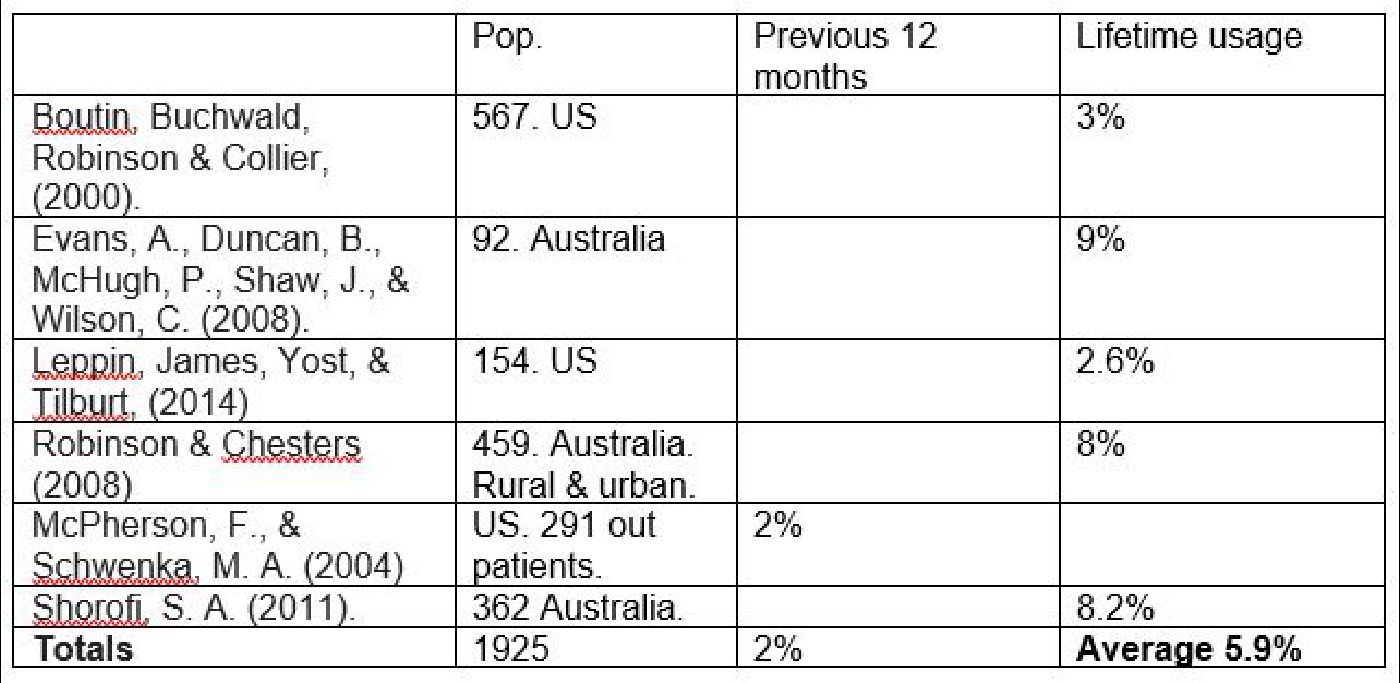A brief systematic review of hypnotherapy usage in the English speaking world
by Matthew Krouwel BA (Hons), D.Hyp, PDCHyp, MBSCH
As a hypnotherapist of 16 years, who has taught hundreds of hypnotherapists, I forget just how unusual for most people hypnotherapy can seem. Of late I’ve been conducting research into the public perceptions of hypnotherapy and one of the questions raised by this research was ‘how many people are actually using hypnosis?’. In this article I’m going to attempt to answer the question of just how many people use hypnotherapy?
So I carried out a brief systematic review…
Systematic review
Search strategy - I searched on Google scholar under the key words ‘hypnotherapy usage’, excluding patents and citations.
Inclusion – Articles were included if they appeared to contain primary information about what percentage or calculable percentage of the general public from a country with English as its first language, had used hypnotherapy in a defined period. Information was sought exclusively from English language peer review journals.
Exclusion – Articles were excluded if they were about;
• Under 18’s.
• Professionally interested populations (health care professionals and allied professions, including hypnotherapists).
• Solely interested in a condition specific population, such Irritable bowel patients, oncology patients, but the broader category of out-patients or in-patients was included as this was likely to contain a more varied population.
Findings - In total google listed 3520 results which were reviewed by title in line with the inclusion/ exclusion criteria below. 7 met criteria of which 1 was unobtainable (Herron & Glasser 2003) through google or my university data base access.

References
Boutin, P. D., Buchwald, D., Robinson, L., & Collier, A. C. (2000). Use of and attitudes about alternative and complementary therapies among outpatients and physicians at a municipal hospital. The Journal of Alternative & Complementary Medicine, 6(4), 335-343.
ECC ( 2005) English Church Census 2005 http://www.eauk.org/church/research-and-statistics/english-church-census.cfm - accessed 13.12.16
Evans, A., Duncan, B., McHugh, P., Shaw, J., & Wilson, C. (2008). Inpatients' use, understanding, and attitudes towards traditional, complementary and alternative therapies at a provincial New Zealand hospital. The New Zealand Medical Journal (Online), 121(1278).
Herron, M., & Glasser, M. (2003). Use of and attitudes toward complementary and alternative medicine among family practice patients in small rural Illinois communities. The Journal of Rural Health, 19(3), 279-284.References
Leppin, A., James, K., Yost, K., & Tilburt, J. (2014). The Fuzzy Edge of CAM Use: Challenges in What Constitutes CAM Use in Self-Administered Questionnaires. The Journal of Alternative and Complementary Medicine, 20(5), A130-A130.
McPherson, F., & Schwenka, M. A. (2004). Use of complementary and alternative therapies among active duty soldiers, military retirees, and family members at a military hospital. Military medicine, 169(5), 354-357.
Robinson, A., & Chesters, J. (2008). Rural diversity in CAM usage: The relationship between rural diversity and the use of complementary and alternative medicine modalities. Rural Society, 18(1), 64-75.
Shorofi, S. A. (2011). Complementary and alternative medicine (CAM) among hospitalised patients: reported use of CAM and reasons for use, CAM preferred during hospitalisation, and the socio-demographic determinants of CAM users. Complementary Therapies in Clinical Practice, 17(4), 199-205.
Singh (2012) http://www.telegraph.co.uk/culture/books/booknews/9459779/50-Shades-of-Grey-is-best-selling-book-of-all-time.html
worldpopulationreview.com (2015) http://worldpopulationreview.com/countries/united-kingdom-population/ accessed 12.12.16
1. Figure derived from Singh 2012 in conjunction with UK population statistics provided by worldpopulationreview.com (2015)
2. Assuming an average 3 people per house
FOLLOW US